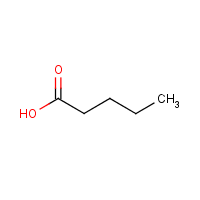n-Pentanoic acid
Agent Name
n-Pentanoic acid
Alternative Name
n-Valeric acid
CAS Number
109-52-4
Formula
C5-H10-O2
Major Category
Other Classes

Synonyms
n-Valeric acid; 1-Butanecarboxylic acid; Butanecarboxylic acid; Kyselina valerova [Czech]; Pentanoic acid; Propylacetic acid; VALERIC ACID, N-; Valerianic acid; Valeric acid; Valeric acid, normal; [ChemIDplus] UN3265
Category
Organic Acids
Description
Colorless liquid with an unpleasant odor; [Merck Index]
Sources/Uses
Used as a sugarcane ripening agent and intermediate; [HSDB] Used in the manufacture of solvents, rodenticides, and fungicides; Present in a variety of plants, fruits, dairy, and meat products; [CHEMINFO]
Comments
A corrosive substance that can cause injury to the skin, eyes, and respiratory tract; [ICSC] Emergency treatment: "Acids"; [HSDB] Causes altered sleep time and seizures in intravenous, lethal-dose studies of mice; [RTECS] Safe when used as a flavoring agent in food; [JECFA] A corrosive substance that can cause injury to the skin, eyes, and respiratory tract; Inhalation may cause chemical pneumonitis; [MSDSonline]
Biomedical References
Exposure Assessment
Vapor Pressure
0.196 mm Hg
Odor Threshold Low
0.00062 ppm
Odor Threshold High
0.0008 ppm
Lethal Concentration
LC50 (mice) = 2,050 mg/m3/4h
Explanatory Notes
Flash point = 96 deg C; [Hawley] Odor threshold (low) and (100% recognition) from CHEMINFO; The Guide in the Emergency Response Guidebook is for "Corrosive liquid, acidic, organic, n.o.s." VP from ChemIDplus;
NFPA
must be preheated
Adverse Effects
Toxic Pneumonitis
Yes
Dermatotoxin
Skin burns
Diseases, Processes, and Activities Linked to This Agent
Processes
Industrial Processes with risk of exposure: